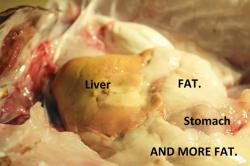 “Do you know what this is?” James Morris looks at me, eyes twinkling, as he points to the guts of a dissected lionfish in his lab at the National Ocean Service’s Center for Coastal Fisheries and Habitat Research in Beaufort, N.C. I see some white chunky stuff. As a Ph.D. candidate at the Hawaii Institute of Marine Biology, I should know basic fish biology literally inside and out. When I cut open a fish, I can tell you which gross-smelling gooey thing is the liver, which is the stomach, etc.
“Do you know what this is?” James Morris looks at me, eyes twinkling, as he points to the guts of a dissected lionfish in his lab at the National Ocean Service’s Center for Coastal Fisheries and Habitat Research in Beaufort, N.C. I see some white chunky stuff. As a Ph.D. candidate at the Hawaii Institute of Marine Biology, I should know basic fish biology literally inside and out. When I cut open a fish, I can tell you which gross-smelling gooey thing is the liver, which is the stomach, etc.
He’s testing me, I think to myself. Morris is National Oceanic and Atmospheric Administration’s pre-eminent scientist studying the invasion of lionfish into U.S. coastal waters. He’s the lionfish guy, and we met in person for the first time just a few days earlier. We’re processing lionfish speared by local divers, taking basic measurements, and removing their stomachs for ongoing diet analyses. Not wanting to look bad, I rack my brain for an answer to his question. It’s not gonads. Not spleen. I’m frustrated with myself, but I simply can’t place the junk; I’ve never seen it before. Finally, I give up and admit that I’m completely clueless.

Photo by Christie Wilcox
“It’s interstitial fat.”
“Fat?”
“Fat,” he says firmly. I look again. The white waxy substance hangs in globs from the stomach and intestines. It clings to most of the internal organs. Heck, there’s got to be at least as much fat as anything else in this lionfish’s gut. That’s when I realize why he’s pointing this out.
“Wait … these lionfish are overweight?” I ask, incredulous.
“No, not overweight,” he says. “Obese.” The fish we’re examining is so obese, he notes, that there are even signs of liver damage.
Obese. As if the lionfish problem in North Carolina wasn’t bad enough.
Though comparing invasions is a lot like debating if hurricanes are more devastating than earthquakes, it’s pretty safe to say that lionfish in the Atlantic is the worst marine invasion to date—not just in the United States, but globally. Lionfish also win the gold medal for speed, spreading faster than any other invasive species. While there were scattered sightings from the mid-1980s, the first confirmation that lionfish were becoming established in the Atlantic Ocean occurred off of North Carolina in 2000. Since then, they have spread like locusts, eating their way throughout the Caribbean and along every coastline from North Carolina to Venezuela, including deep into the Gulf of Mexico. When lionfish arrive on a reef, they reduce native fish populations by nearly 70 percent. And it’s no wonder—the invasive populations are eight or more times as dense than those in their native range, with more than 450 lionfish per hectare reported in some places. That is a lot of lionfish. Read more….
